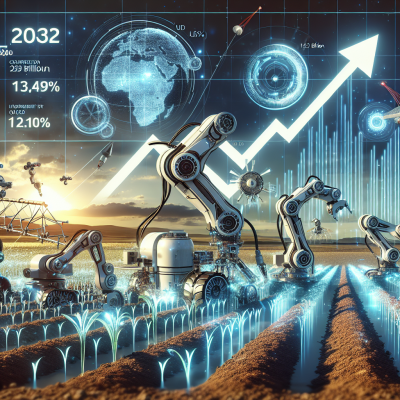
Revolutionizing Agriculture Through Robotics
The integration of robotics into precision agriculture is transforming farming as we know it. As the global population continues to grow, so does the demand for more efficient, sustainable, and scalable food production methods. Robotics, combined with advanced data analytics and automation, are enabling farmers worldwide to meet these challenges head-on. The Robotics in Precision Agriculture Market is projected to surge to USD 12.31 billion by 2032, growing at a CAGR of 14.96%, underscoring the massive potential this fast-evolving field holds.
What is Robotics in Precision Agriculture?
Robotics in precision agriculture refers to the application of autonomous machines, artificial intelligence, and machine learning to manage agricultural operations with high accuracy and minimal human intervention. These technologies support tasks such as:
- Soil analysis and monitoring
- Autonomous planting and harvesting
- Pest and disease detection
- Fertilizer and pesticide application
- Crop health assessment through drones and sensors
These capabilities result in increased yield, resource optimization, and reduced environmental impact—key drivers in modern farming.
Global Market Trends Driving Growth
Several factors are fueling the rapid uptake of robotics in the agricultural sector worldwide:
1. Labor Shortages
With increasing labor scarcity in rural areas and rising labor costs globally, automation offers a viable solution to maintain uninterrupted agricultural productivity.
2. Rising Food Demand
By 2050, the global population is expected to reach nearly 10 billion. Robotics enables efficient land use, optimal input application, and precision in yield forecasting, all crucial for boosting food output sustainably.
3. Government Initiatives and Subsidies
Many governments are supporting the adoption of smart farming technologies through financial incentives, promoting wider access to automation tools in agriculture.
4. Technological Advancements
Innovations in AI, machine vision, robotics hardware, and IoT are enabling machines to perform increasingly complex tasks with minimal supervision.
Key Technologies Shaping the Market
The robotics in precision agriculture landscape comprises several groundbreaking technologies that contribute to its impressive growth trajectory:
Autonomous Tractors
Driverless tractors are equipped with GPS, sensors, and AI-enabled systems that allow for efficient navigation and operation across fields with minimal human input.
Drones and UAVs
Unmanned aerial vehicles are vital for crop surveillance, soil assessment, and pesticide spraying. They’re capable of covering large areas in a fraction of the time with remarkable precision.
AI-Driven Robots
These robots can detect weeds, analyze soil health, and even handpick delicate crops using computer vision—a capability that’s revolutionizing labor-intensive segments like berry harvesting.
Swarm Robotics
This emerging trend involves deploying groups of smaller, coordinated robots that work collectively to perform tasks such as planting, irrigation, and pest control. Swarm robotics enhances redundancy and scalability in farm operations.
Eco-Friendly and Sustainable Practices
One of the most significant advantages of robotics in agriculture is its alignment with sustainability goals. Smart robots optimize water usage, reduce fertilizer waste, and minimize chemical runoff—making farming not only more efficient but also environmentally responsible.
In addition, precision agriculture enables:
- Better soil preservation through minimal tillage techniques
- Reduction in greenhouse gas emissions with optimized machinery usage
- Energy conservation by replacing fuel-hungry tractors with electric or solar-powered robots
Opportunities and Challenges in the Market
While the market presents extensive growth opportunities, it also faces certain barriers that need addressing to ensure widespread adoption:
Opportunities:
- Expansion of agritech startups focused on robotics and AI
- Growing venture capital interest in agribusiness automation
- Increased affordability of precision tools for smallholder farmers
Challenges:
- High initial investment and maintenance costs
- Limited technical know-how in developing regions
- Integration difficulties with legacy farm equipment and infrastructure
Regional Adoption and Market Leaders
The adoption of agricultural robotics is gaining momentum globally, with notable activity in regions such as:
- North America: Home to several agritech innovators and early adopters, particularly in the U.S. and Canada.
- Europe: Progressive farming practices in countries like Germany and the Netherlands are accelerating uptake.
- Asia-Pacific: With countries like Japan, China, and India embracing automation to address food security and labor crises.
Major players operating in this market include John Deere, AGCO Corporation, Trimble Inc., Naïo Technologies, and Blue River Technology, among others. These companies are investing heavily in R&D to enhance robot intelligence, durability, and integration capabilities.
Looking Ahead: The Future of Robotics in Precision Agriculture
As the global agricultural sector faces mounting pressure to produce more with fewer resources, robotics and automation will continue to shape the future of farming. New developments in machine learning, edge computing, and real-time data analytics will make farm robots even more intuitive and responsive to dynamic environmental conditions.
In the coming years, we can expect:
- Smarter farm management systems powered by AI and big data
- Micro-robots capable of plant-level interventions
- Collaborative human-machine agricultural systems
These innovations will not only drive productivity but also foster a more sustainable, resilient food system worldwide.
Conclusion
The rise of robotics in precision agriculture marks a pivotal moment in the evolution of global farming. From enhanced crop monitoring to autonomous harvesting, these technologies are transforming how we grow food. As the market moves toward a projected valuation of USD 12.31 billion by 2032, it’s clear that the synergy of robotics, AI, and sustainability holds the key to feeding future generations efficiently and responsibly.
Farming is no longer just about plows and tractors—today, it’s about sensors, circuits, and smart machines reshaping the agricultural landscape from the ground up.


Leave a Reply